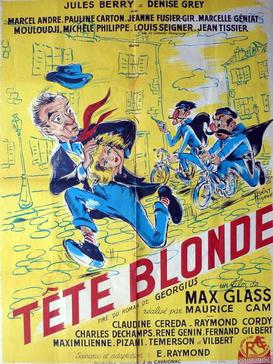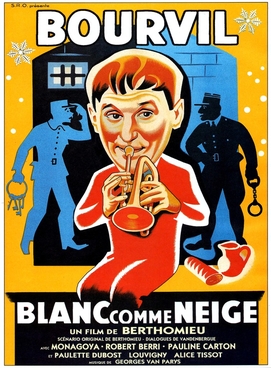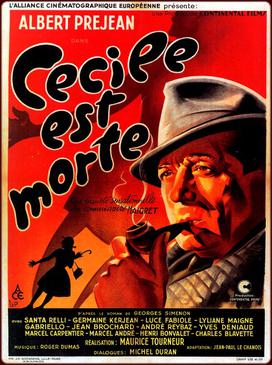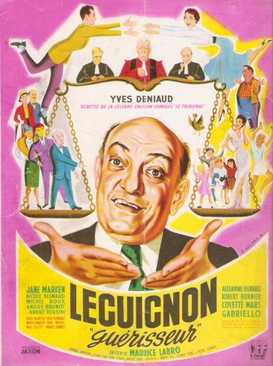
Daniel Ceccaldi was a French actor.
Yves Hyacinthe Deniaud was a French comic actor and musical comedian.

Paul Meurisse was a French actor who appeared in over 60 films and many stage productions. Meurisse was noted for the elegance of his acting style, and for his versatility. He was equally able to play comedic and serious dramatic roles. His screen roles ranged from the droll and drily humorous to the menacing and disturbing. His most celebrated role was that of the sadistic and vindictive headmaster in the 1955 film Les Diaboliques.

Monsieur Leguignon, Signalman is a 1952 French comedy film directed by Maurice Labro and starring Yves Deniaud, Jane Marken and Bernard Lajarrige. It was shot at the Boulogne Studios in Paris. The film's sets were designed by the art director Paul-Louis Boutié. It was based on a radio programme and was followed by a sequel Leguignon the Healer in 1954.

Three Telegrams is a 1950 French drama film directed by Henri Decoin and starring Gérard Gervais, Pierrette Simonet and Olivier Hussenot. The film's art direction was by Auguste Capelier. It was made at the Billancourt Studios in Paris.

Five Red Tulips is a 1949 French crime film directed by Jean Stelli and starring René Dary, Suzanne Dehelly and Raymond Bussières. It was shot at the Billancourt Studios in Paris and on location around the city and across France. The film's sets were designed by the art director Jacques Colombier.

Blonde is a 1950 French comedy crime film directed by Maurice Cam and starring Jules Berry, Denise Grey and Marcel André. The film's sets were designed by the art director Guy de Gastyne.
Interpol Against X is a 1960 French crime film directed by Maurice Boutel and starring Howard Vernon, Maria Vincent and Andrex. It is also known by the alternative title of Dossier AST-555.

My Husband Is Marvelous is a 1952 French comedy film directed by André Hunebelle and starring Fernand Gravey, Sophie Desmarets and Elina Labourdette. The film's sets were designed by the art director Lucien Carré. While a follow-up to the 1951 film My Wife Is Formidable which had the same director and cast, it is not a sequel.

White as Snow is a 1948 French comedy film directed by André Berthomieu and starring Bourvil, Mona Goya and Paulette Dubost. It was shot at the Saint-Maurice Studios in Paris. The film's sets were designed by the art director Raymond Nègre. It was a hit, with admissions in France of 3,666,283.

The Benefactor is a 1942 French crime film directed by Henri Decoin and starring Raimu, Suzy Prim and Pierre Larquey. It was shot at the Cité Elgé Studios in Paris. The film's sets were designed by the art director Serge Piménoff.

Cecile Is Dead is a 1944 French crime film directed by Maurice Tourneur and starring Albert Préjean, Santa Relli and Germaine Kerjean. It is based on the 1942 novel of the same title by Georges Simenon featuring his detective Jules Maigret.

Sergil Amongst the Girls is a 1952 French crime film directed by Jacques Daroy and starring Paul Meurisse, Claudine Dupuis and Colette Deréal.

Fantomas Against Fantomas is a 1949 French mystery thriller film directed by Robert Vernay and starring Marcelle Chantal, Aimé Clariond and Alexandre Rignault. It portrays the fictional master criminal Fantomas, who has had numerous films depicting his adventures.
Guy Decomble (1910–1964) was a French film and television actor. A character actor he played in a number of supporting parts in postwar cinema. One of his better known roles is as the teacher in The 400 Blows by François Truffaut.

Leguignon the Healer is a 1954 French comedy film directed by Maurice Labro and starring Yves Deniaud, Jane Marken and Nicole Besnard. The film's sets were designed by the art director Jean Douarinou. It was made as a sequel to the 1952 film Monsieur Leguignon, Signalman.

The Last of the Six is a 1941 French mystery thriller film directed by Georges Lacombe and starring Pierre Fresnay, Michèle Alfa and Suzy Delair. It was shot at the Billancourt Studios in Paris. The film's sets were designed by the art director Andrej Andrejew. It is based on the 1931 novel The Six Dead Men by the Belgian writer Stanislas-André Steeman.

The Shadow is a 1948 French crime drama film directed by André Berthomieu and starring Fernand Ledoux, Renée Faure and Berthe Bovy. It was based on a 1933 novel of the same title by Francis Carco. It was shot at the Saint-Maurice Studios in Paris. The film's sets were designed by the art director Raymond Nègre

Love Letters is a 1942 French historical drama film directed by Claude Autant-Lara and starring Odette Joyeux, François Périer and Julien Carette. It was shot at the Boulogne Studios in Paris during the German Occupation. The film's sets were designed by the art directors Robert Dumesnil and Jacques Krauss while the costumes were designed by Christian Dior.

The Darling of His Concierge is a 1951 French comedy film directed by René Jayet and starring Jean Parédès, André Gabriello and Paulette Dubost. The film's sets were designed by the art director Aimé Bazin. It is a remake of the 1934 film of the same title starring Fernandel.

















